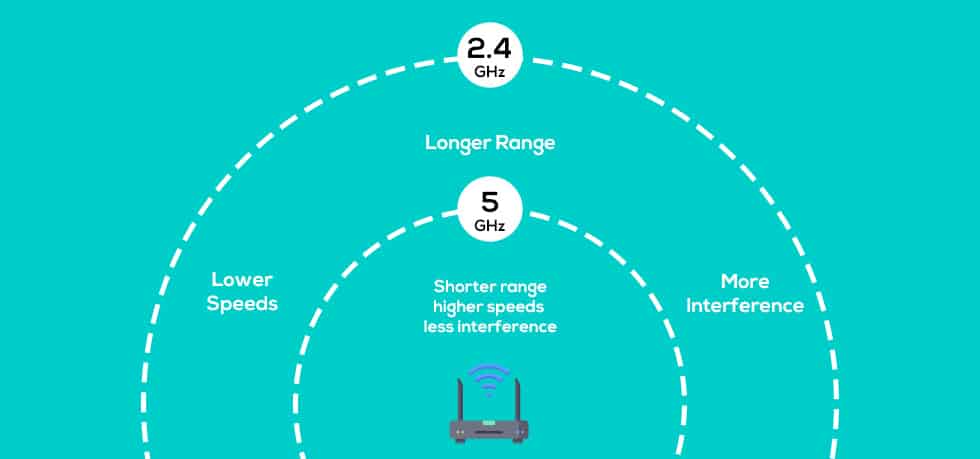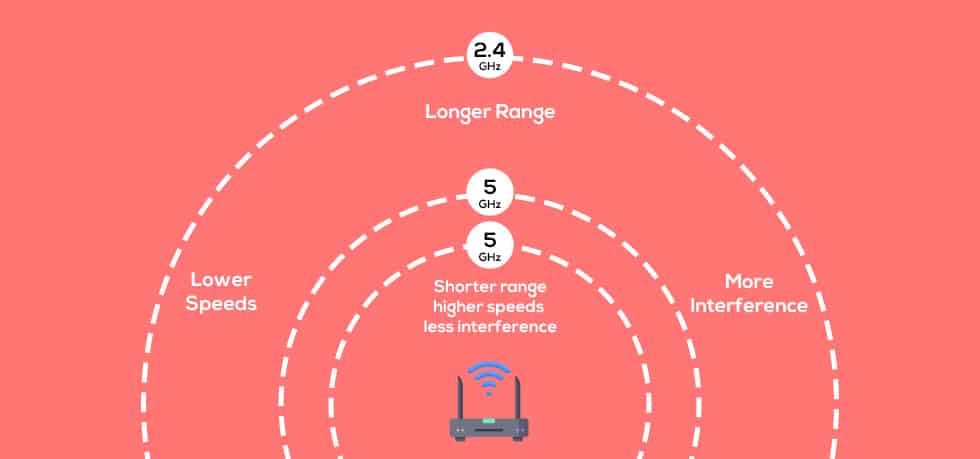For a long time, I’ve been getting requests for a detailed comparison between Dual and Tri Band WiFi, as the folks were confused about what is a better choice in 2023. Then recently, a lot of WiFi 6E routers came into the market with an additional 6GHz band, which made the equation even more complex.
Moving forward, we will see advancements in WiFi technology and, in turn, your requirements. So, it’s an understatement to say the choice is complex. But take my word, the difference between dual-band and tri-band WiFi is significant as it’s the only time an additional band was added.
Therefore, in this article, I have indulged in a detailed comparative analysis of dual-band and tri-band WiFi frequencies on several grounds to help you make a profound decision.
Contents
Dual Band vs Tri Band: Quick Comparison
| Aspects | Dual Band | Tri Band |
|---|---|---|
| Main Difference | 1. Balanced Throughput 2. Designed for a few Devices 3. Affordable Price | 1. Higher Throughput 2. Designed for a lot of Devices 3. Increased Cost |
| Suitability | 1. Small-Medium Homes 2. Small Businesses 3. Small Offices | 1. Large Homes 2. Business Enterprises 3. Large Offices |
| Frequencies | Two (2.4GHz + 5GHz) | Three (2.4GHz + 5GHz + 5GHz) |
| Wireless Coverage | No Difference (Depends on Model) | No Difference (Depends on Model) |
| Average Cost of Routers | $60 - $300 | $150 - $500 |
| Release Year | 2009 | 2014 |
Now, before I dig into the tri band vs dual band discussion, it’s important to understand what exactly is dual and tri-band, and how they work.
What is Dual Band WiFi?
Dual-band WiFi transmits data over two different frequencies: 5GHz and 2.4GHz, hence the name.

This transmission can take place one band at a time or simultaneously to let you perform your tasks without worrying about network drops and speeds. Hence, you may consider a dual-band router if you want an upgrade over your super old and outdated router.
The 5GHz frequency band operates at a high frequency, is much faster, and has fewer interferences from other devices. The 2.4GHz band is generally slower but offers great coverage and is better at going through thick walls, floors, or other blockers. Want to learn all differences? Read my 2.4 GHz vs 5 GHz comparison.
The good news is that you can allocate the bands for different tasks. For example, professional games, work from professionals, and streamers might lay claim to the 5GHz band while keeping the 2.4GHz band for tasks that don’t need a lot of bandwidth.
What is Tri Band WiFi?
Tri-band WiFi transmits data over three different frequencies: two 5GHz and one 2.4GHz.

They typically add a second 5GHz band to increase the available network bandwidth and, in turn, boost the speeds. Plus, two separate 5GHz bands allocate devices into different networks, which offers you greater speed to share amongst your devices.
Dual Band vs Tri Band Router: Detailed Comparison
The below-discussed factors should help you decide on a dual-band or tri-band router. So, let’s get going!
1. Speeds & Latency
Speeds are the major differential factor between dual-band and tri-band routers. The latter offers much faster internet speeds than the former.
As mentioned before, tri-bands offer greater WiFi channel width than dual-band ones, which aren’t interfered with by nearby devices operating in a particular frequency, as is the case with the latter.
So, a tri-band is a better choice if you want a router to connect multiple devices. The speeds stay consistent and high. However, if you’re connecting a handful of devices, both bands are practically the same.
Are you unsure of what speeds are considered ‘Good’? Give this article a read. I’ve clarified internet speeds and suitability for different activities and users.
2. Throughput Capacity
Network throughput depends on the data transfer rate over a given communication channels, such as packet radio or Ethernet in a network. So, the faster data gets transferred, the greater the throughput.
Now, with an extra 5GHz frequency band, the number of channels is greater in a tri-band than in a dual-band, delivering greater throughput.
In other words, you can perform all your bandwidth-intensive tasks like playing online games, streaming 4K video, and others with lesser lags with a tri-band in contrast to dual-band WiFi.
3. Wireless Coverage
There aren’t many differences between dual-band and tri-band in wireless coverage. As I’ve already mentioned, the 2.4GHz band is primarily responsible for signal strength and WiFi coverage, and there’s a little alteration due to the addition of an extra 5GHz band.
4. Applications & Suitability
Dual-band is suitable for a home with a few devices, and the speed requirement won’t be higher as you aren’t involved in bandwidth-intensive tasks like live streaming, cloud gaming, and more.
That’s where a tri-band router comes into play. With it, you can perform network-heavy activities on devices with minimal or no lag.
Tri-Band Wi-Fi 5 vs Dual-Band Wi-Fi 6: Which Excels Better?
Now, if you’re confused about whether to invest in a tri-band WiFi 5 router or a dual-band WiFi 6 router here is what I’d suggest:
First, determine your purpose behind purchasing a router.
For instance, if you are in pursuit of speed, coverage, and overall performance, then go for the Tri-band Wi-Fi 5 system. Adding an extra 5GHz or 6GHz band adds to its speed and throughput. But you won’t be able to experience the Wi-Fi 6 speeds. This should be fine if you don’t own Wi-Fi 6 compatible smart gadgets.
On the other hand, if you need a future-proof router compatible with upcoming high-speed plans, advanced security features, and greater network efficiency, dual-band Wi-Fi 6 is an optimal choice.
Compatibility is the major issue of a Wi-Fi 6 standard, and as of now, few devices benefit from Wi-Fi 6. So, check if your devices are compatible with it; if not, there’s no point in considering it.
Pros & Cons of Dual Band WiFi
- Supports new and old devices
- Stable signal and connection
- Cheaper than a tri-band router
- Speed decreases with multiple connected devices
- Not suitable for bandwidth-intensive tasks
Pros & Cons of Tri-Band WiFi
- Better performance from two 5GHz channels
- Less congestion and better traffic handling
- Stable connection
- Consistent throughput
- Expensive
Frequently Asked Questions
In terms of speed, performance, and consistency, a tri-band router is better than a dual-band router. However, not many devices are compatible with the latter, which can pose a major disadvantage.
Depends. If you have a tri-band compatible device and are pursuing greater speed and throughput, then yes, you need tri-band Wi-Fi.
Wi-Fi 6, being new in the market, doesn’t have many devices compatible with it. So irrespective of offering better speeds and being future-proof, it’s no use if you don’t have a compatible device to connect with.
A 2.4GHz frequency band travels farther at slower speeds, while 5GHz bands offer faster speeds in a shorter range. So, your choice of a band depends on how you’re using your Wi-Fi connection.
Bands in Wi-Fi refers to how your wireless data is transmitted from one device to another. Currently, 2.4GHz and 5GHz bands are used in most routers, while the 6GHz band is present in a few. The higher the frequency, the greater the speed and the lesser the coverage.
Conclusion
With that comes an end to my comparison of dual-band vs tri-band WiFi. A tri-band router might seem like a Hercules of routers, but considering the state of your devices and home network, you might not get much value out of it. And considering the Herculean price it comes in, a dual-band with 802.11ax might be a good bet.
However, if you’re using DOCSIS 3.1 modem with an internet plan higher than 800 Mbps, a tri-band router might amp up your speed significantly. Saying that I’d leave. Let me know your opinions and thoughts in the comments below.

Leave a Reply